WAN (wide area network) acceleration is a broad category. There are many ways to optimize or accelerate data transfers across WANs, like data caching, bandwidth management, deduplication, compression, and more.
In this guide, we’ll give you a high-level overview of WAN acceleration, including the common issues that occur when moving data over long distances (e.g., latency, packet loss, network congestion, and so on), and the most popular implementation techniques for overcoming them.
To help you find the right tool for your needs, we’ll discuss the six best WAN acceleration solutions, organized into two categories:
- UDP-based WAN accelerators: Resilio Active Everywhere, IBM Aspera, and Signiant. These newer WAN accelerators focus on bandwidth utilization by moving data as quickly and efficiently as possible across the network.
- SD-WAN accelerators: Riverbed SteelHead, Silver Peak, and FatPipe. These earlier solutions were primarily designed to keep unnecessary traffic off the network by caching and deduplicating chatty apps.
We’ll also show you exactly how a modern WAN optimization solution works in the face of Resilio Active Everywhere — our WAN-optimized data replication, sync, and file gateway solution. Resilio works well for any type of IP network: from poor quality, low-bandwidth connection (VSAT, cell, WiFI, or intermittent broadband) to the fastest networks over distance.
Click here for an overview of Resilio’s UDP-based approach for faster networks.
Specifically, you’ll learn how Resilio Platform delivers:
- Quick, efficient, and reliable data transfer, sync, and replication across any network. Our solution’s proprietary, UDP-based WAN optimization technology, unique P2P architecture, and advanced deduplication enable you to achieve industry-leading transfer speeds while overcoming latency and packet loss regardless of distance.
- Smart delta detection and synchronization. Resilio efficiently discovers, replicates, and synchronizes changes at the file level. When a file changes, only the changed portion of the file is synced. Resilio does this extremely efficiently in real-time and in any direction. Other “real-time” solutions can only do this point-to-point between two endpoints. Resilio can do this “N-way” in a full mesh, making it extremely efficient for remote work and other use cases over the WAN.
- Granular bandwidth management controls. You can create bandwidth policies that govern how much bandwidth each endpoint can use, so you can easily scale from Gbps to Mbps (and vice versa).
- Maximized bandwidth utilization and optimized data transfer over any IP network. Our WAN optimization technology is designed to make the most out of every network (including VSAT, broadband, cell, Wi-Fi, and more) even if it’s slow or unreliable. This makes Resilio ideal for lots of use cases, including remote data collection and ingestion in extreme environments.
- Efficient data transfer and sync. Besides transferring only the changed portion of your files, Resilio Platform lets you minimize unnecessary data movement by caching frequently accessed data locally, pinning traffic to an optimal network, and selectively downloading and syncing any file.
- A single point of management for all files and jobs. Resilio’s Central Management Console lets you control all aspects of data transfer, sync, and replication from one place — including setup, monitoring, and troubleshooting.
- Minimal latency for end users. You can replicate and cache data in the cloud regions or on-prem environments that are closest to them. Plus, your team can use Resilio Platform for efficient, low-latency access to data located anywhere on the globe.
Companies like Cisco, Exxon, Mercedes-Benz, Blizzard, Warner Brothers, and more use Resilio Platform to achieve incredibly fast, reliable, and efficient file transfer, sync, and replication. For more details on how Resilio can help you accelerate WAN transfers over any network, schedule a demo with our team.
WAN Acceleration 101: Definition, Benefits, and Techniques
The term WAN acceleration refers to various techniques and solutions that aim to increase the speed and efficiency of data transfer across WANs (wide area networks). These techniques help companies:
- Overcome the impact of network latency, packet loss, and congestion.
- Obtain full utilization of expensive, high-speed WAN connections.
- Control and manage bandwidth through allocation policies.
- Transfer data across WANs more efficiently.
- Make the most out of any WAN connection.
There are many WAN acceleration techniques that can deliver these benefits by targeting issues like latency, duplication, chattiness, and others that typically occur when moving data across large distances.
Some of the most commonly used techniques are:
- Data caching, which includes storing data in local caches for efficient and low-latency access.
- Data deduplication, which removes “chatty” or unnecessary redundant data from traversing the WAN.
- Data compression, which uses various algorithms to represent data more efficiently and reduce its size.
- Protocol acceleration, which minimizes the impact chatty apps have on the WAN.
- Bandwidth management, which involves measuring and controlling the communications on a network link. Having good bandwidth management controls is crucial for the WAN acceleration processes as it lets you avoid overfilling the link and prevent network congestion. There’s a separate category of specialized bandwidth management tools, although some WAN accelerators like Resilio Platform also come with powerful bandwidth management capabilities.
- Protocol spoofing, which bundles multiple requests from chatty applications into one. This technique can also include stream-lining protocols such as CIFS (Common Internet File System).
- Traffic shaping, network management and monitoring, and more.
Put simply, there’s a ton of variety when it comes to WAN optimization techniques. As a result, there are also many different WAN acceleration solutions that can apply different combinations of these techniques.
SD-WAN (software-definedwide area network) solutions emerged first. They allow companies to centrally manage multiple WAN links, optimize network traffic, cache, dedupe, and compress chatty apps at the edge. There are both software-based SD-WANs like Silver Peak and Riverbed and hardware-based SD-WAN acceleration appliances products like Cisco’s 4000 Series Integrated Services Routers.
In contrast, newer WAN accelerators like Resilio Active Everywhere are designed to obtain full utilization of bandwidth by replacing the more standard TCP (Transmission Control Protocol) with the faster and more efficient UDP (User Datagram Protocol).
Below, we’ll look at three solutions from each category, with a focus on their main benefits and use cases.
3 Best UDP-Based WAN Acceleration Solutions
These solutions use the UDP, instead of the more standard TCP. UDP-based tools enable companies to overcome TCP’s downsides (mainly the fact that latency and packet loss degrade its performance) and obtain full utilization of bandwidth by pushing data as efficiently as possible across the network.
This makes UDP-based WANs a good fit if you’re looking to move large files or large numbers of files to multiple endpoints across the globe quickly and reliably.
1. Resilio Active Everywhere

Resilio Active Everywhere uses a proprietary, UDP-based WAN optimization technology and a unique P2P architecture to transfer or synchronize payloads of any size across any network, quickly, reliably, and efficiently irrespective of distance.
Resilio Platform incorporates elements of traditional WAN optimization, like caching and data deduplication. Our solution also leverages UDP to get data across networks that have high latency and packet loss in a smart, reliable, and predictable way.
You can use Resilio for use cases around data transfer, sync, and replication like:
- Easy, controllable bandwidth management.
- Quickly transferring large files across many geographically dispersed endpoints.
- Moving large amounts of data from the deep edge into the cloud (or moving data from the cloud to edge locations) over unreliable networks, including Wi-Fi, VSAT, cell, broadband, and more.
- Simplifying data replication, sync, ingest, transfer, and access by controlling all aspects from a single Central Management Console.
Unlike most SD-WANs and UDP-based WAN optimization solutions, Resilio Active Everywhere’s P2P replication architecture lets every device with a Resilio agent on it transfer data simultaneously. As a result, you can eliminate single points of failure, replicate data in any direction, and sync multiple endpoints simultaneously.
In the next sections, we’ll discuss exactly how Resilio Platform works and how it can help you achieve fast, reliable, and secure transfers across all networks.
Proprietary, UDP-Based WAN Optimization Technology
Resilio Platform uses a proprietary, UDP-based transfer protocol called Zero Gravity Transport™ (ZGT) that intelligently analyzes the underlying network. It does that by measuring packet loss, latency, and throughput over time, which enables it to automatically:
- Adjust and maintain consistent speed.
- Adapt to changing conditions in real-time.
- Maximize network performance and the utilization of any connection, including broadband, VSAT, Wi-Fi, cell, and more.
If you’re interested in how this technology works, check out our detailed WAN Optimization Whitepaper. In a nutshell:
- ZGT’s congestion control algorithm constantly probes the RTT (Round Trip Time) in order to identify and maintain the ideal data packet send rate.
- The sending device sends file packets periodically with a fixed packet delay to create a uniform packet distribution over time.
- ZGT retransmits lost packets in groups once per RTT in order to decrease unnecessary retransmissions.
- It also uses interval acknowledgments for groups of packets to enhance transfer speed, with each acknowledgment containing information about lost packets.
Resilio Platform can also save you time and reduce the strain on your network when there’s an outage, network failure, or another similar issue with checksum restarts. Checksum restarts allow our solution to resume the transfer where it left off once your system is up and running again, so you’re not transferring the same data all over again.
ZGT is also optimized for unreliable networks. You can always rely on it to replicate, sync, or transfer data from the edge to a centralized location in the cloud or in your data centers in predictable timeframes.
This versatility and reliability make it ideal for tons of scenarios, like:
- Deploying updates and security patches to vehicles, vessels, and other machines operating at the edge.
- Collecting data from geographically dispersed sites, machines, and vehicles.
- Distributing time-sensitive data quickly and reliably across the globe.
- Syncing branch offices located in low-connectivity areas.
If you’re interested in how this technology can benefit your business, we have a free speed calculator on our website. You can use it to estimate how much time Resilio Platform can help you save based on your use case.
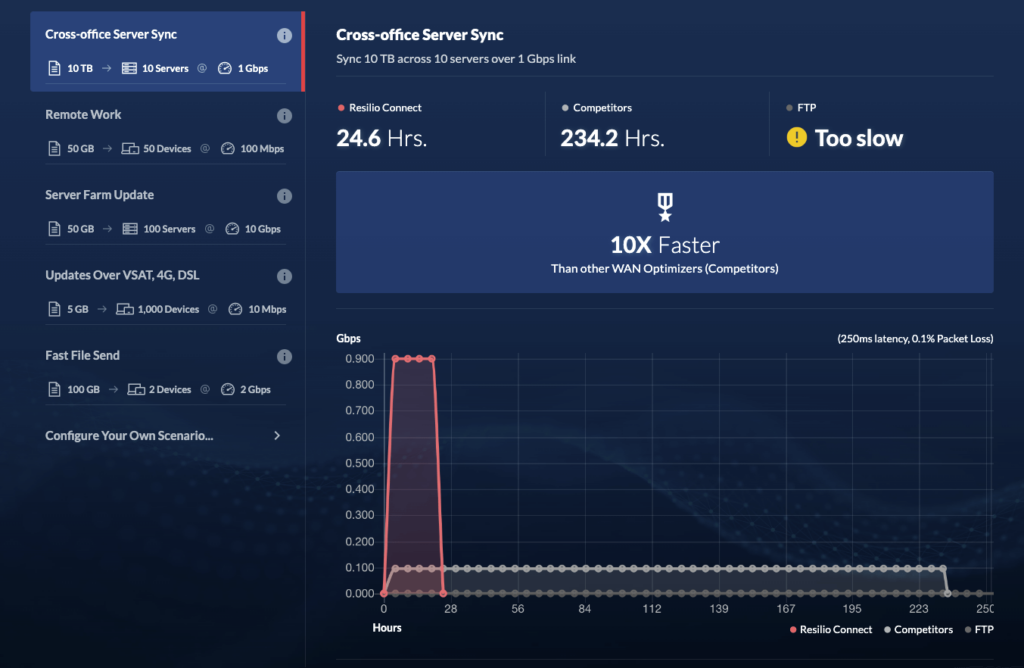
Easy, Granular Bandwidth Management
As we said earlier, bandwidth management is crucial for avoiding network congestion and poor WAN performance.
That’s why Resilio Platform lets you create bandwidth utilization policies that govern how much bandwidth each endpoint can use during certain times of the day and on certain days of the week.
This is controlled via our Central Management Console (which we discuss in a bit) and Bandwidth Scheduler. The Scheduler lets you create and edit these schedules and later assign them to groups of Resilio agents.
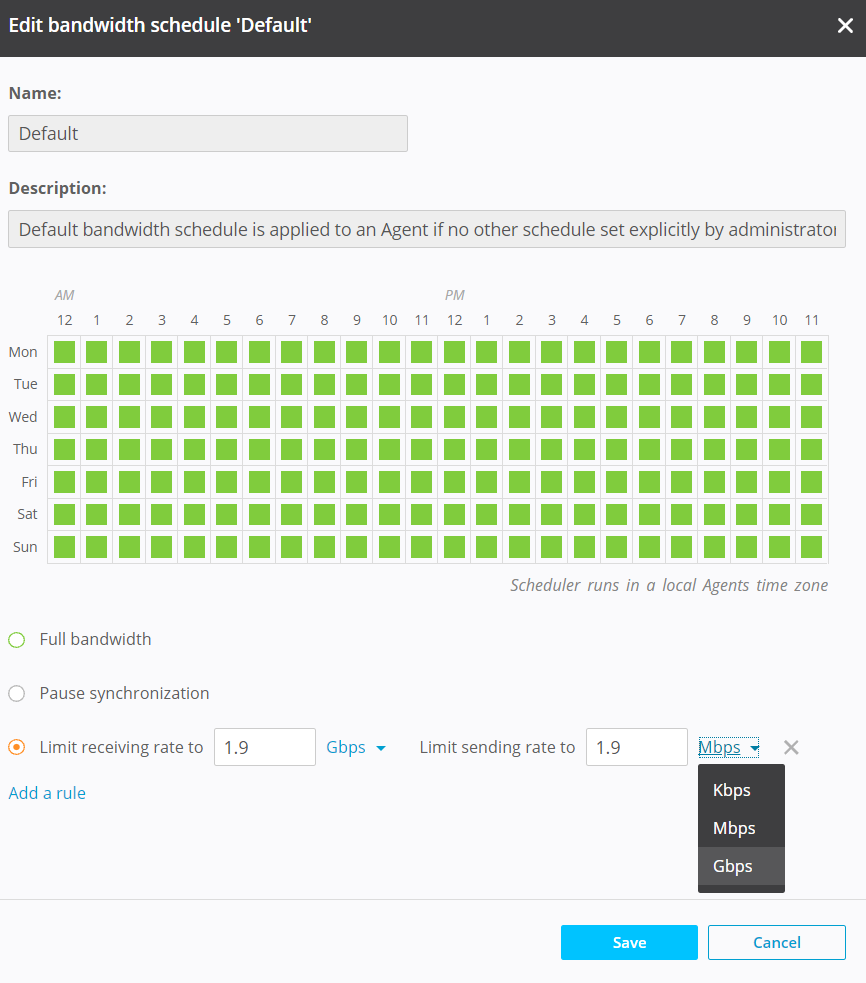
As you can see in the image, you can choose to use the full available bandwidth or limit the receiving and sending rates. You can also add up to five custom rules, each dictating limits to upload and download speeds.
For more details on how this capability works, refer to this article on our Bandwidth Scheduler.
Unique P2P (Peer-to-Peer) Architecture
Many replication, file transfer, and WAN optimization solutions use a point-to-point architecture. This architecture comes in one of two flavors — client-server and “follow-the-sun”:
- In the client-server model, servers in an environment are separated into clients and hubs. The clients can’t share data directly with each other. Instead, they have to send it to the hub, which can then transfer it across the other clients.
- In the “follow-the-sun” model, replication can only occur sequentially between two servers. For example, Server 1 can replicate data to Server 2; when the job completes, Server 2 can then replicate to Server 3, and so on.
In both cases, you’re faced with some serious downsides. Transfers are limited to two devices at a time, so speeds are limited and unpredictable. In the case of client-server transfers, you’re also dealing with cloud hopping — the requirement for servers to share data with the hub first before it can be transferred to the entire environment — which leads to even more slowdowns.
Plus, there’s always a single point of failure. If one of the devices transferring data experiences an outage, network failure, or any other issue, the transfer process gets interrupted and has to start over.
Due to these limitations, point-to-point solutions aren’t a good choice for syncing large files (and large numbers of files) or syncing to many endpoints.
Resilio Platform uses a unique P2P (peer-to-peer) architecture that avoids all these downsides.
Specifically, P2P lets every device in your environment take part in the transfer of files simultaneously. This means you can take full advantage of your environment’s bandwidth.
The more servers you have, the faster the transfer time. This is in stark contrast to point-to-point environments where transfer speeds slow down with more devices because transfers only ever occur between two of them at a time.

Resilio Platform also uses file chunking to separate files into chunks and transfer them independently from each other. This combination of capabilities has a few key benefits for organizations:
- Industry-leading speed: We have achieved transfer throughput speeds of over 100 Gbps. In early tests of a next-generation release, we’ve even seen speeds of 200 Gbps across Azure regions. We’ve also transferred 500 GB of data in the Google Cloud Platform from London to Australia in 50 seconds.
- Organic scalability: In traditional client-server environments, adding more servers makes the entire environment slower and more expensive. With Resilio, adding more endpoints only speeds up transfers and increases available bandwidth. As a result, you can utilize the full bandwidth of your environment to sync thousands of systems and millions of files quickly, reliably, and efficiently.
- Omnidirectional sync: Resilio Platform can sync data in any direction — one-to-one, one-to-many, many-to-one, or N-way. With N-way replication, you can quickly sync a large number of servers (because each one can sync across others in the environment) and enhance remote work collaboration (because everyone can share file changes instantly with their colleagues around the globe).
- No single point of failure and active-active high availability: Resilio Platform ideal disaster recovery solution for companies that want to meet sub-five-second RPOs and RTOs within minutes of an outage. Our solution can dynamically route around outages and always retrieve data from another endpoint in case of network failures or other similar problems.
Overall, the combination of P2P architecture, file chunking, and WAN optimization makes Resilio Platform an incredibly fast, reliable, efficient, and flexible solution.
Here are a few examples of how companies in different industries use Resilio’s versatile capabilities:
- VoiceBase (technology) uses Resilio Platform to distribute 50 GB of files to 400 servers quickly and reliably.
- Skywalker Sound (media) uses Resilio Platform to enable sound editors to work efficiently from home.
- Northern Maritime Group (maritime transport) uses Resilio Platform to distribute critical software updates quickly and reduce the time needed to bring the fleet into compliance by 92%.
Efficient File Access and Transfers
In addition to overcoming the impact of latency and packet loss, Resilio Platform is very efficient when it comes to moving and deduplicating data across any network.
Our solution detects and only transfers the changed portion of files. That way, unnecessary data never gets transferred over the network.
Plus, you have the option to selectively cache files on local devices, which is a great option for frequently accessed files. It can help you minimize expenses and reduce cloud egress costs because users don’t have to download locally cached files from the cloud every time.
Resilio also has two other key features for increasing efficiency:
- Smart Routing, which lets you pin traffic to the optimal network. For example, say you use a large cloud provider’s network (like Azure, AWS, or GCP) for most of your workflows. You can choose to move parts of your traffic from the cloud provider’s network to a remote edge network, so you optimize costs by using a cheaper LAN instead of an expensive WAN connection.
- Transparent Selective Sync (TSS), which lets you browse, download, and sync files on demand. For example, you can use TSS to browse objects stored in the cloud as files and perform any action on them, like download, partial download, or sync. With this granular control, you can always make sure that no unnecessary data gets moved across the network.
Our engineers are also constantly working to make Resilio Platform even more efficient. In a recent update, we reduced the average memory footprint required on replication jobs by 80% by optimizing time, merging, CPU usage, indexing, storage I/O, and end-to-end transport.
Finally, Resilio gives users easy, efficient, and low-latency access to all your data (or to the files you’ve shared with them). This is done through a unified interface that operates much like Microsoft OneDrive, which is familiar and intuitive for most users.
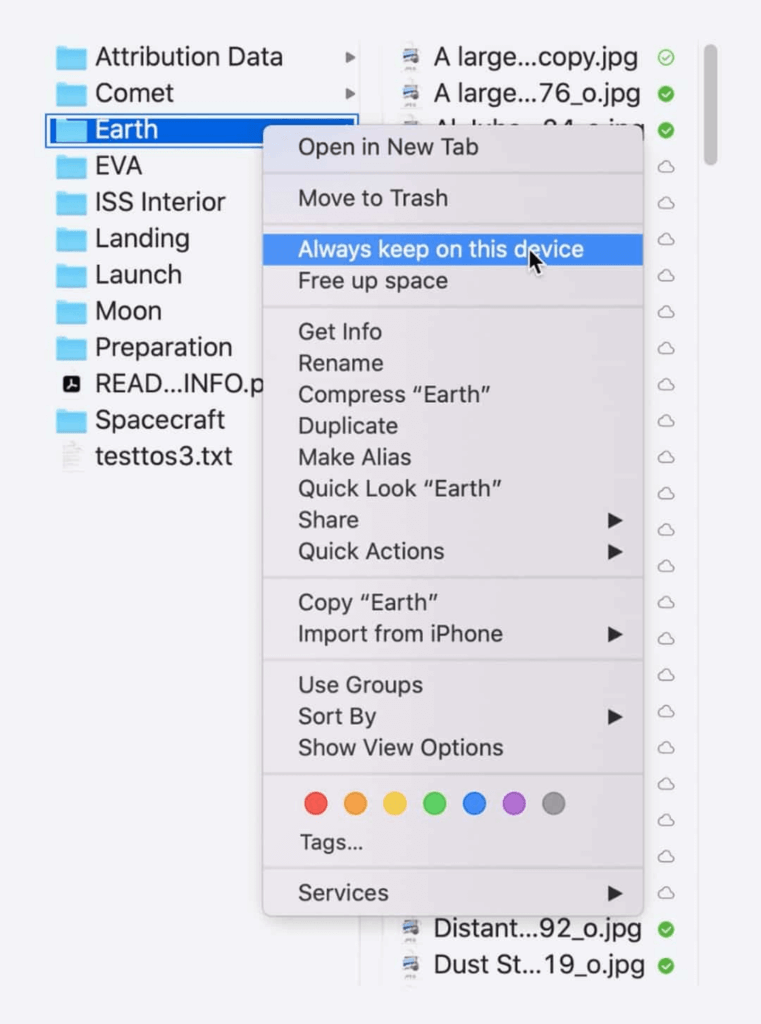
For example, say you have data stored across on-prem environments and cloud storage services like Azure Blobs, Amazon S3, and Google Storage. Using TSS, your team can get a unified view of all these files and download the ones they want to your on-prem devices (where they can be cached locally). Files that are not fully downloaded remain in the cloud but still appear local, which saves local storage capacity.
Deployment Flexibility across Any Cloud, On-Prem, and Hybrid Cloud Environments
Resilio Platform is a cloud-agnostic software that builds on open standards, open file formats, and a multi-cloud architecture. It’s also a software-only solution, so you don’t need to purchase new hardware and train your team on it.
This means you can install Resilio and use it with:
- Physical machines, including desktops, servers, laptops, mobile devices, and (most) NAS devices. Our solution is compatible with all popular operating systems, like Linux (a variety of distros), FreeBSD, Open BSD, Microsoft Windows, Mac, and Android.
- AWS S3, Google Object Storage, Azure, Cloudian, Ceph, MinIO, VAST Data, Wasabi, WekaIO, and any other S3-compatible storage. You can also use any type of storage, including file, object, and block.
- Virtual machines, such as Citrix, VMware, and hypervisors.

The deployment options and Resilio’s software-only nature allow you to set up our solution on your existing infrastructure and begin transferring, syncing, and replicating data in as little as two hours.
This flexibility also helps you avoid vendor lock-in. For example, you can just as easily and reliably move your data across the networks of cloud providers like AWS, Azure, GCP, Backblaze, and more. You can freely build or tear down projects in any cloud or system without being confined to a certain ecosystem.
Centralized Management and Automation
Resilio Platform comes with a Central Management Console that gives you a unified view of data transfer, replication, and sync jobs across any region, cloud provider, or on-prem environment.
This makes it much easier to understand exactly what data you’re moving across the network and gives you a single point of management for all your files.
You can use the Central Management Console to:
- Configure user permissions for who can access, view, and edit your data.
- Create new replication, transfer, and sync jobs and monitor their progress.
- Automate how synchronization occurs at each endpoint in your environment.
- Set up real-time progress notifications that can be sent via email or webhooks.
- Script any type of functionality your job requires with Resilio’s REST API.
- Adjust key parameters like buffer size, bandwidth usage policies, and disk I/O threads.
You also have a centralized view of all key metrics for tracking each job’s progress, like duration, ETAs, number of Resilio agents, number of agents, total bytes to transfer, maximum speed, and more.

Lastly, you can store the console pretty much anywhere, including:
- In any virtual or physical Windows or Linux instance.
- In a VM instance in a cloud provider (Azure, AWS, Google Cloud, etc.) or in your on-prem environment.
Enterprise-Grade Security Features (Built-In)
When working with Resilio Active Everywhere, you don’t need to purchase separate security software to ensure your data is protected. Our solution comes with native state-of-the-art security features that have been reviewed by 3rd-party security experts.
These features include:
- AES 256 encryption for data at rest and in transit.
- Cryptographic data integrity validation, which ensures files arrive uncorrupted and intact.
- Mutually authenticated endpoints, which have to be pre-approved in order to receive data, so data arrives only at its intended destination.
- Data immutability, which Resilio achieves by storing immutable copies of data in the public cloud to protect you from ransomware and data loss.
- Access management, so you can set granular permissions that govern who can access, view, edit, and copy your files.
- And much more.
For a more detailed look at how Resilio Platform can benefit your business, schedule a demo with our team.
2. IBM Aspera

Aspera helps companies transfer files and stream data across the globe. It removes underlying bottlenecks to fully utilize available network bandwidth and maximize speed. While it was acquired over 10 years ago, Aspera continues to exist as a standalone brand under the IBM umbrella. Overall, it’s a useful solution for large files in a single direction (e.g., from one team to another or to external partners).
Learn more: IBM Aspera Alternative for Fast Transfer of Large Files
3. Signiant

Signiant offers a line of products including Jet, Media Shuttle, and Flight Deck. These tools help companies move large files across the world using various optimization techniques. Overall, these products are good for point-to-point transfers (especially for media and entertainment companies) but aren’t suitable if you need to synchronize, distribute, or ingest files.
Learn more: 5 Signiant Alternatives for Large File Transfers & Sync
3 Top SD-WAN Acceleration Solutions
SD-WAN solutions have existed for a long time and have traditionally been focused on keeping unnecessary traffic off the network by caching and deduplicating chatty apps. They can help you monitor latency and packet loss, implement techniques like caching and deduplication, and organize network traffic.
Compared to UDP-based WAN accelerators from the previous category, SD-WANs are a better fit for companies with more generic and simple app acceleration needs (as opposed to moving or syncing large files across WANs quickly and reliably).
1. Riverbed SteelHead
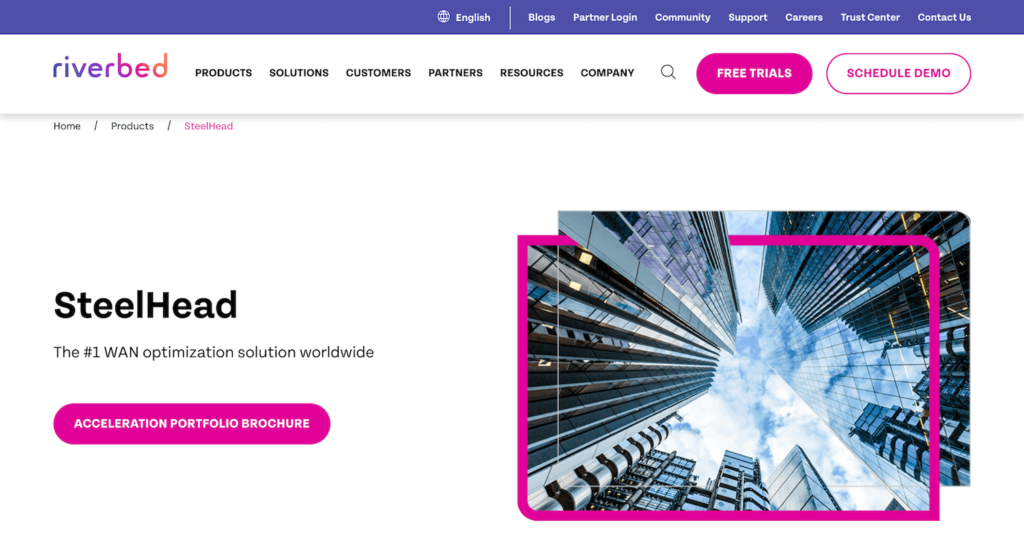
Riverbed SteelHead is an SD-WAN solution for monitoring, managing, and accelerating WAN performance. According to RiverBed’s website, SteelHead can achieve up to 99% data reduction and 33x faster application performance by overcoming latency, congestion, and sub-optimal last-mile conditions. Besides SteelHead, Riverbed also offers a suite of other solutions for cloud acceleration, SaaS application acceleration, and more.
2. Silver Peak
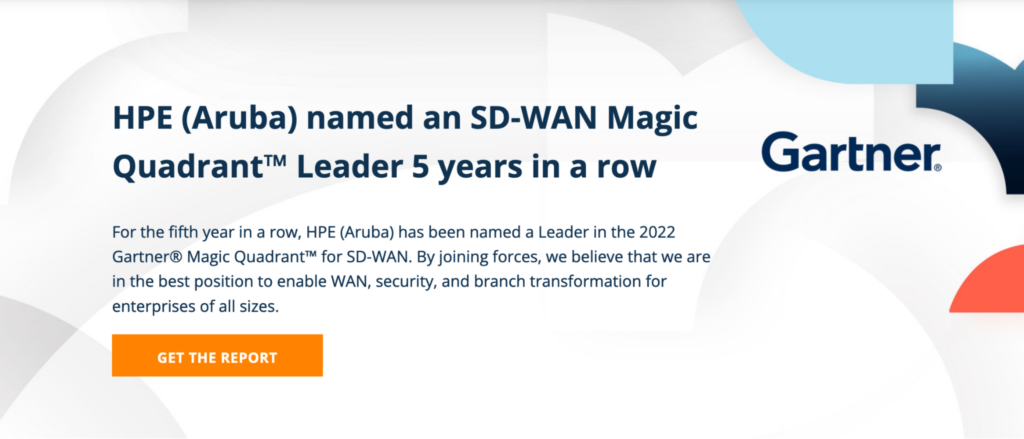
Silver Peak is a popular SD-WAN and edge security solution that was acquired by Aruba (an HP company) in 2020. It helps companies move to a secure access service edge (SASE) architecture by combining various capabilities, including a secure SD-WAN, a firewall, routing, an accelerated IPSec VPN, and more. This model helps companies ensure secure remote access, protect against threats, and safeguard sensitive data in SaaS apps.
3. FatPipe
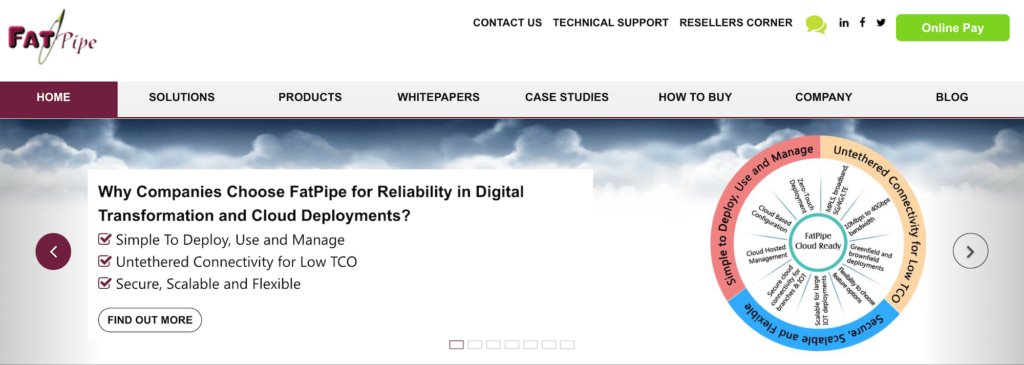
FatPipe SD-WAN is a product by FatPipe Networks that simplifies the deployment and management of connectivity at remote locations. It helps companies manage their WANs and branch office configurations, as well as deploy apps with the zero-touch installation. It also has an advanced policy management that lets cloud apps be routed directly out of local Internet connections while maintaining corporate security policies (although many of FatPipe’s security features have to be purchased as add-ons).
Accelerate Data Transfer, Sync, and Replication across Any Network with Resilio Active Everywhere
Resilio Platform is an ideal solution for companies that need lightning-fast, reliable data file transfer across networks, regardless of distance.
Our software’s proprietary, UDP-based WAN optimization technology overcomes latency and packet loss across any network (including broadband, Wi-Fi, VSAT, cell, and more) and ensures you’re utilizing 100% of the available bandwidth. Its P2P architecture removes single points of failure and enables you to achieve industry-leading speeds by using your environment’s full potential.
Overall, Resilio Platform is:
- Easy to manage, as you can control all aspects of data transfer and access from a single interface. You can also create bandwidth policies that govern how much bandwidth each endpoint can use during certain times of the day and on certain days of the week.
- Highly resilient, fault-tolerant, and ideal for disaster recovery scenarios, since it doesn’t have a single point of failure.
- Organically scalable because it performs better as you add more endpoints.
- Efficient, as it only transfers or syncs the changed portion of files, so no unnecessary data gets moved across the network.
- Flexible, as you can use it with various storage types, cloud providers, on-prem infrastructure, and hybrid cloud environments.
- Secure, thanks to AES 256 encryption and other security features that have been verified by 3rd-party security experts.
To learn more about how Resilio Platform can help your business, schedule a demo with our team.





